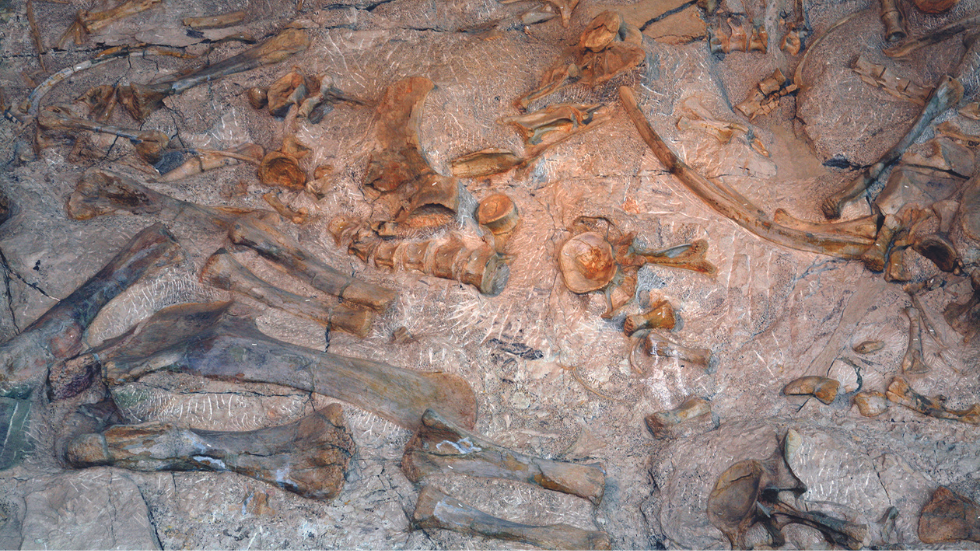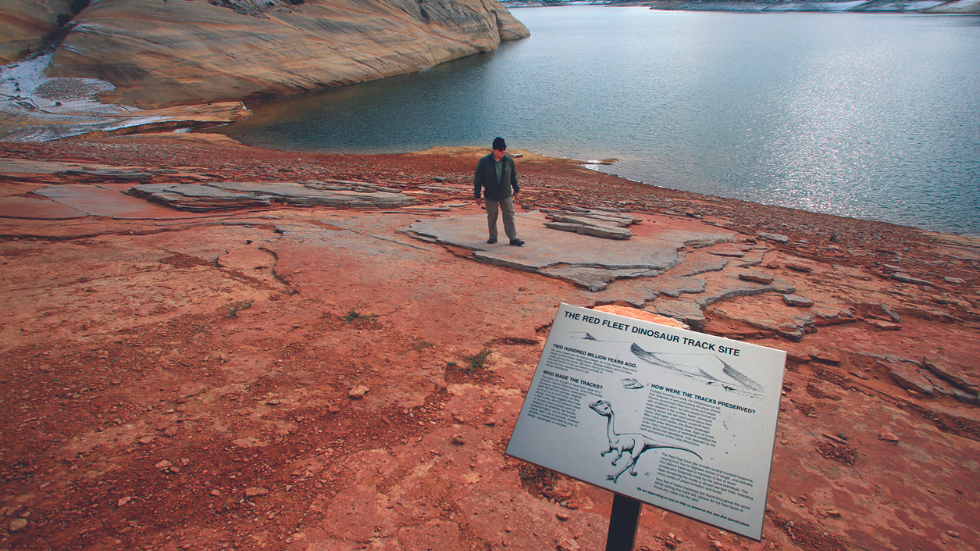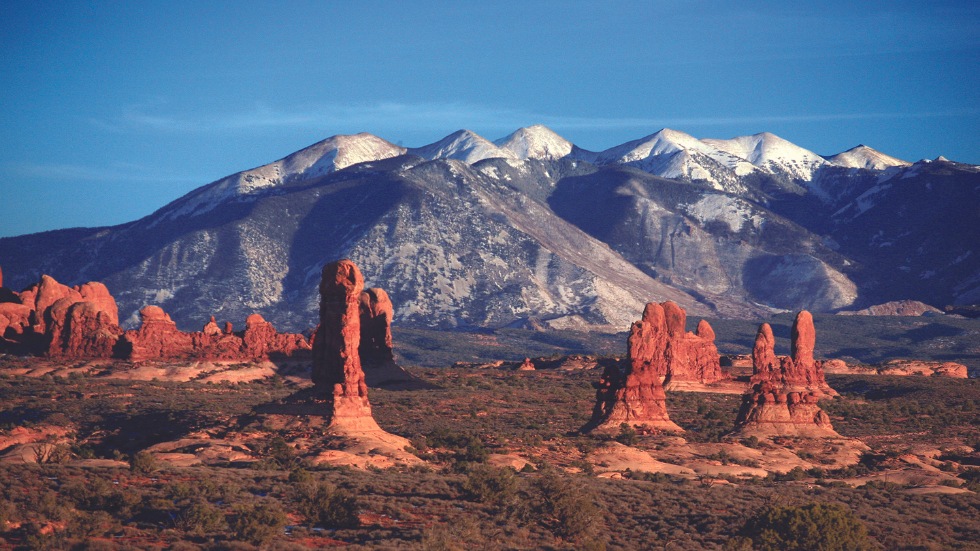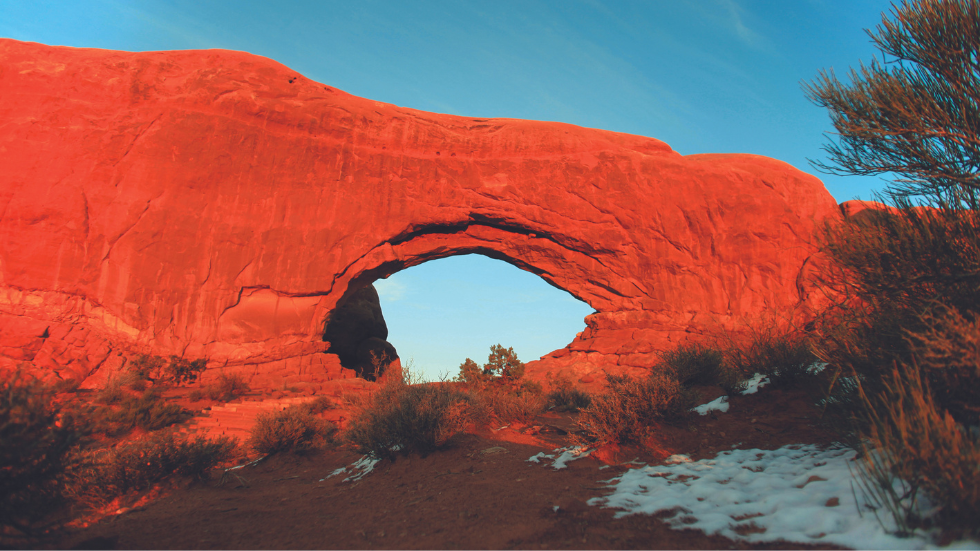Dinosaur Highway takes you on a road trip to prehistoric times
The Dinosaur Diamond National Scenic Byway through Colorado and Utah is a road trip for the ages
.png?iar=0&mw=3840)
I am just not seeing it. Like a farsighted voyeur who’s infatuated with rocks, I’m close up and squinting at a truck-size slab jutting above scrubby terrain, trying to decipher a relic exposed by erosion after a 140-million-year subterranean slumber. “Step back and it’s more obvious,” suggests Jeff, my road-trip companion who’s also got a thing for the past. I move back a bit and recast my gaze. Suddenly, the marvel is revealed. The chain of embedded rust-colored chunks protruding ever so slightly from the beige stone becomes the fossilized backbone of a certain 60-foot-long plant-eating dinosaur called Camarasaurus. A nearby sign explains that seeing fossils right under your nose can take practice. No kidding!
 Colorado’s Rabbit Valley Trail Through Time fossil quarry; Photo by Ted Alan Stedman
Colorado’s Rabbit Valley Trail Through Time fossil quarry; Photo by Ted Alan Stedman
We’re hiking the one-and-a-half-mile Rabbit Valley Trail Through Time just east of the Colorado–Utah border. It includes the renowned Mygatt–Moore Quarry, an ancient watering hole where thousands of dinosaurs over thousands of years met their demise. Today, fossils from these toothy titans of the Jurassic and Cretaceous geological periods lie exposed for curious humans like us. As one of some 20-odd prehistoric attractions along the Dinosaur Diamond loop, it’s a fitting finale to a prehistoric journey we’d begun four days earlier in nearby Fruita, Colorado. The 486-mile Dinosaur Diamond loop is one of the few scenic byways in America to span two states. Colorado’s section is the Dinosaur Diamond Scenic and Historic Byway, while Utah’s is called the Dinosaur Diamond Prehistoric Highway. The route courses through the high, arid Colorado Plateau, traversing red-rock canyons, forested sky islands, intermittent riverways and far-flung towns etched with plenty of Old West character. The entire route was approved as a National Scenic Byway in 2002 with the goal of preserving and educating the public on the cultural, historical and paleontological resources found along the route. Attractions include ancient rock art as well as famous dinosaur quarries, track sites and paleontological museums, with Dinosaur National Monument, the nation’s preeminent fossil factory, taking center stage.

We began the journey in Fruita, exploring the dino-rich digs of the Riggs Hill Trail and perusing the Dinosaur Journey Museum’s life-size animatronic specimens and fossils. Aiming north to Rangely along lonely State Highway 139, the landscape takes on an otherworldly feel entering Canyon Pintado National Historic District, home to hundreds of archaeological sites from the Fremont Culture (AD 0 to 1300). Eerie-looking petroglyphs of whimsical figures seem to stare at us from their stone ramparts, enticing us to make more stops than a school bus.
 The ‘Wall of Bones’ display of embedded cliffside fossils in Dinosaur National Monument; Photo by Ted Alan Stedman
The ‘Wall of Bones’ display of embedded cliffside fossils in Dinosaur National Monument; Photo by Ted Alan Stedman
For pure prehistoric pleasure, Dinosaur National Monument is the hands-down highlight of the byway. The 210,000-acre monument straddling the Colorado–Utah border preserves the trove of dinosaur fossils discovered in 1909 by Earl Douglass. A paleontologist at Pittsburgh’s Carnegie Museum of Natural History, Douglass sensed the significance of what he had discovered, so rather than extract the fossils, he curtailed the excavation to preserve them in their original form, which was considered scientific anathema in the day. Thanks to Douglass’ decision, the ancient denizens are frozen in time, a vertical boneyard of 1,500 jarringly protruding skulls, femurs and other fossilized remnants protected inside a structure that was built around them, right in the quarry. Limited hands-on encounters are encouraged, and the visceral sensation of touching a 149-million-year-old Allosaurus was close to rapture for two long-time dino junkies.
The beguiling landscapes we encountered throughout the journey have a way of making T. rex and other raging relics seem weirdly alive. Mesas, arches, pinnacles, lava flows and deserts all testify to the region’s tumultuous past.
 A 200-million-year-old Dilophosaurus track in Red Fleet State Park; Photo by Ted Alan Stedman
A 200-million-year-old Dilophosaurus track in Red Fleet State Park; Photo by Ted Alan Stedman
Next, near Vernal, we spend a half-day on the trail to visit the dinosaur trackways at Red Fleet State Park, another location where practice makes perfect when trying to identify the eroding 200-million-year-old tracks of the three-toed sauropod, the long-necked herbivores that are the most massive land animal to have walked the planet. While here, we also stop by the Utah Field House of Natural History Star Park Museum, a repository for a multitude of fossils, dinosaur skeletons and educational exhibits sure to satiate the curiosity of any fossil fanatic.
 Red Fleet State Park’s dinosaur trackway is preserved in the slickrock shore of its reservoir; Photo by Ted Alan Stedman
Red Fleet State Park’s dinosaur trackway is preserved in the slickrock shore of its reservoir; Photo by Ted Alan Stedman
Farther south in Price, we ogle fossils collected at the Utah State University Eastern Prehistoric Museum, where Steven Spielberg did research for his first Jurassic Park blockbuster. The museum displays fossils unearthed at the nearby Cleveland–Lloyd Dinosaur Quarry, an active dig site recognized worldwide for having the densest assortment of Jurassic-era fossils ever discovered.
 Utah’s Arches National Park and the mountains of Manti-La Sal National Forest; Photo by Ted Alan Stedman
Utah’s Arches National Park and the mountains of Manti-La Sal National Forest; Photo by Ted Alan Stedman
As our route drifts back toward Colorado, we visit the surreal Martian-like landscape of Arches National Park along US Route 191 heading to Moab. With prominent weather-sculpted red Navajo sandstone that sometimes seems to take on animal forms, it might be the best place on Earth to stoke the imaginations of dino lovers. Not that fossil evidence is in short supply. Adjacent to the park’s western border, we hike the Copper Ridge Dinosaur Trackway and inspect a score of large footprints thought to be made by hulking Apatosaurus and Allosaurus.
 The North Window Arch in Arches National Park; Photo by Ted Alan Stedman
The North Window Arch in Arches National Park; Photo by Ted Alan Stedman
Yet the best here was still ahead at the nearby fossil-rich quarter-mile interpretive trail at the Mill Canyon Dinosaur Tracksite on remote public land at mile marker 149 off US 191. This hands-on fossil encounter is like walking through a natural history museum, except all the exhibits are outside. Stopping at various markers, we find darkened fossilized objects embedded in beige stone: a mishmash of vertebras, tibias and a pelvis portion from one very large lumbering sauropod.
Venturing nearly 500 miles in two states, we’ve only scratched the surface in our prehistoric quest along the Dinosaur Diamond loop. More sites continue to be excavated, with more chapters of Earth’s ancient history unfolding. For two road-weary travelers infatuated with dinosaurs since we were kids, it’s a road trip that will go down in history.
